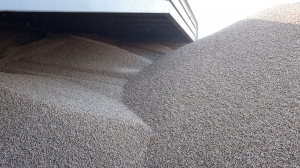


(Posted on 02/11/20)
The conversion of Amercentrale’s fifth turbine will be rounded off after the summer. At that point, 90 percent of the electricity and heat produced by the Brabant power station will be generated from wood pellets. While this is a logical step forward in plant owner RWE’s pursuit of its sustainability targets, it does come with challenges of its own.
Most of the storage and handling of pellets for Amercentrale is handled by Dordrecht-based ZHD Stevedores. ‘In the past, biomass came in from a variety of ports. But nowadays, these flows primarily run via Dordrecht and Rotterdam,’ says Dico Regoord, Commercial Manager at ZHD. Around 75 percent of the pellets are transferred to inland vessels via ship-to-ship handling at various buoys in Rotterdam. The family business relies on its own fleet of self-propelled floating cranes. The remaining quarter undergoes a similar procedure at Dordrecht Sea Port, providing the draught of the sea-going vessel (9.45 metres max) allows this. ‘With five turbines, you’re easily talking about thousands of tonnes per day. This runs smoothly enough if everything goes as planned and the weather helps. But naturally, we’re also prepared for possible peaks in the supply chain. Do we have sufficient warehouse space? Can we spread out handling activities? Could a share of the stock be diverted to Eemscentrale? Is additional floating storage an option? We also work in close partnership with RWE’s highly experienced wood pellet logistics desk – so together, we’re usually able to find a good solution.’
RWE intends to operate on a climate-neutral basis by 2040. And by 2030, the company will already have reduced its carbon emissions by 70 percent. This won’t pose a problem in the case of Amercentrale. RWE is working hard to convert the fifth of the station’s total of six turbines from firing coal to firing biomass. And this is quite complicated, explains Amercentrale’s director Chris Scheerder. ‘As a product, wood pellets are completely different to coal. For example, they are far more affected by rain. This forces us to make far-reaching changes to the plant’s internal logistics. Different to coal, we’re using a closed system with conveyor belts to transport the biomass from the barges to the turbines. But to move the wood pellets we also need to set up an extra fan, for example – one that’s the size of a house. And all these adaptations have to be made while the rest of the plant remains in full operation.’
Another point of attention is the public debate surrounding biomass, which has become more heated over the past few months. Scheerder: ‘All our pellets come from responsible forestry operations in the Baltic states and North America. They satisfy the most stringent sustainability standards and are made from a variety of flows, including prunings – a forestry residual – and residuals from sawmills. Our operations have nothing to do with the destruction of tropical rainforests. And thanks to strict criteria that we’ve drawn up in consultation with conservation and environmental organisations, which are furthermore set down in law and the SDE+ regulations, we have no problem proving this.’
Scheerder also sees new opportunities in wood’s rediscovery as a building material. ‘We can already do a lot more with wood than we used to. You can already find quite a few buildings over 50 metres tall. This sustainable approach to construction has become very popular. And building in wood generates a huge volume of residuals, including sawdust and surplus wood chips. In the near future – as soon as the relevant technology becomes commercially available – we can start by extracting cellulose, sugars and oils from this flow, which can be used as chemical feedstock, for example. And we can make good use of whatever’s left – effectively strengthening the revenue model of the entire chain.’
Wood isn’t the only form of biomass WE is interested in. ‘One of the other things we’re working on is the utilisation of agricultural residuals,’ explains Scheerder. ‘Sugar cane cultivation, for example, yields a huge volume of residuals like stalks and straw. It’s so large that beside other applications for this stream, in the longer term this could also lead to a new market for bagasse pellets. An example of how we can optimise our utilisation of residual flows.’ Another biomass stream that is already being exploited is bentonite or bleaching earth. This absorbent clay, which is used in the food industry, is saturated with vegetable oils. At Amercentrale, the residual stream can be converted into energy and raw materials for the construction sector. ‘A fine example of circular use.’
With this year’s Rail Conference “Rail Freight Transport and Seaports”, a joint initiative... Read more
Asian Bulk Logistics (ABL Group) and ICG have jointly announced the successful completion of ABL&rsquo... Read more
Abu Dhabi based AD Ports Group, a leading global enabler of integrated trade, industry and logistics... Read more
The Executive Board of Hamburger Hafen und Logistik AG (HHLA) has appointed Patrick Krawutschke as Managing... Read more
Abu Dhabi based AD Ports Group, a global enabler of integrated trade, transport, industry, and logistics... Read more
This year marks a significant milestone in maritime innovation as Port Hedland, Australia, celebrates... Read more
Associated British Ports (ABP), the UK’s leading port operator, has announced the latest tranche... Read more
During the Investment, Labour, and Trade Promotion Programme in Japan (November 16–22, 2025),... Read more
AD Ports Group subsidiary Khalifa Economic Zones Abu Dhabi - KEZAD Group, the largest operator of integrated... Read more
Abu Dhabi based AD Ports Group, a global enabler of integrated trade, transport, industry, and logistics... Read more